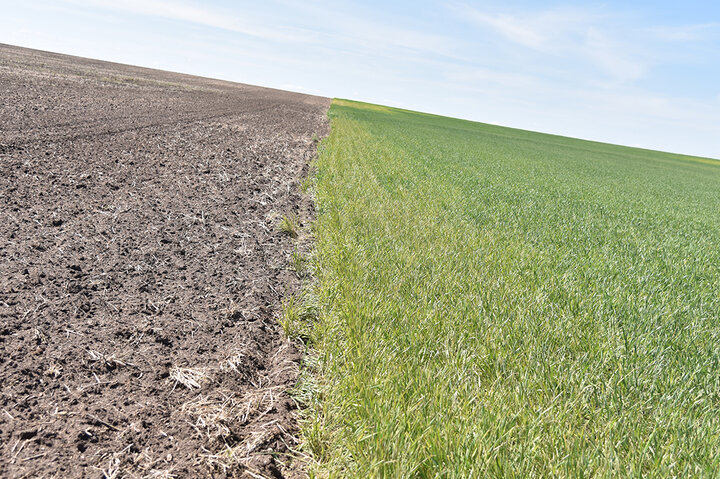A survey of wheat fields in Cheyenne County on June 3 found two major diseases. One field (Figure 1) had severe and widespread barley yellow dwarf. Other fields had varying levels of wheat streak mosaic, from field edges (Figure 2) to entire fields showing symptoms.


Barley yellow dwarf is caused by Barley yellow dwarf virus (BYDV) which affects cereal crops and grasses. The disease can cause significant yield losses of up to 40% in wheat, barley and oats when present at epidemic levels. In wheat, leaves appear pale yellow and tissues immediately adjacent to the midrib may remain green longer (Figure 3). Depending on the wheat variety and cooler temperatures, a red-to-purple discoloration may accompany the yellowing.
Barley yellow dwarf is transmitted by more than 20 species of aphids, the most important of which are the oat bird-cherry aphid, the corn leaf aphid, the English grain aphid and the green bug. Aphids acquire BYDV by feeding on infected plants and transmit the virus in subsequent feedings.

Wheat streak mosaic is caused by Wheat streak mosaic virus (WSMV). It is transmitted by wheat curl mites. Infected plants have mottled and streaked leaves and may be stunted with tillers growing laterally instead of upright. Streaks are parallel, discontinuous, and greenish-yellow (Figure 4). The most damaging infections occur in the fall after wheat emergence. In the spring, yellowing intensifies as temperatures rise. Symptoms can be exacerbated in the presence of one or two additional viruses transmitted by wheat curl mites. These viruses are Triticum mosaic virus and High Plains wheat mosaic virus.
The highest risk for occurrence of wheat streak mosaic is volunteer wheat that emerged from grain shattered by preharvest hail. Wheat curl mites move from the maturing and drying out wheat crop and heavily infest the volunteer wheat which acts as a green bridge for the mites and virus between harvest and fall planting of wheat. If the volunteer wheat is not controlled, the mites move from it to the newly emerged wheat in the fall and transmit WSMV.

Management
There are several management strategies for barley yellow dwarf. Delaying fall seeding of wheat until aphid populations decline minimizes the risk of disease occurrence. Other strategies include planting resistant or tolerant varieties, controlling grassy weeds and volunteer cereals within and near wheat production fields, and controlling aphids with insecticides.
The most effective strategy for managing wheat streak mosaic is to control volunteer wheat, especially preharvest volunteer, before wheat is planted in the fall. Volunteer should be completely dead at least two weeks before planting. A few wheat varieties have good resistance, but the resistance can be overcome under severe infections and hot temperatures.
